The Cm (C minor) chord is a fundamental chord in music specialy on guitar, possessing a dark and melancholic quality that adds depth to musical compositions. As a guitarist, mastering different voicings and fingerings for the Cm chord allows you to infuse your playing with rich variations, enhancing the emotional impact of your music.
In this comprehensive guide, we will explore 16 unique ways to play the Cm chord on the guitar, providing you with a diverse set of tools to incorporate into your playing. Whether you’re a beginner or an experienced guitarist, these chord variations will expand your chord vocabulary and take your musical expression to new heights.
Standard Cm
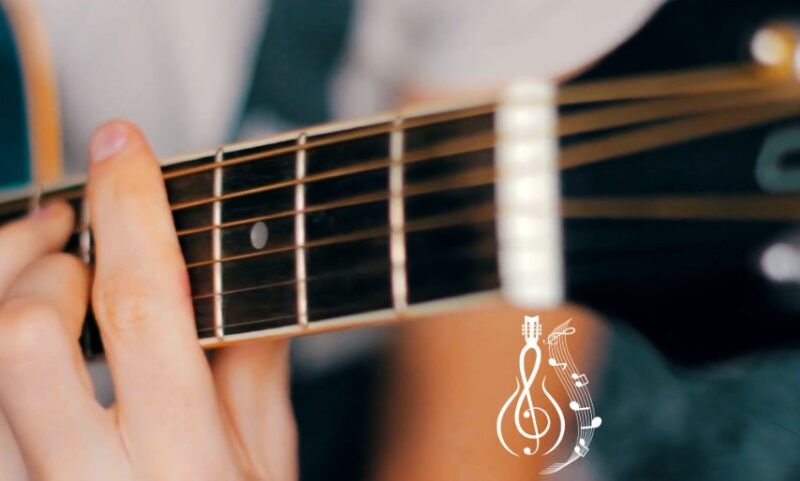
The most common way to play a C minor chord on the guitar is the standard version. To form this chord, place your index finger on the 1st fret of the B string, your middle finger on the 2nd fret of the D string, and your ring finger on the 3rd fret of the A string. Avoid playing the low E string and strum all the other strings. This chord shape provides a solid foundation for exploring other variations.
e|—1—|
B|—1—|
G|—1—|
D|—3—|
A|—3—|
E|—x—|
Cm Barre – A Shape
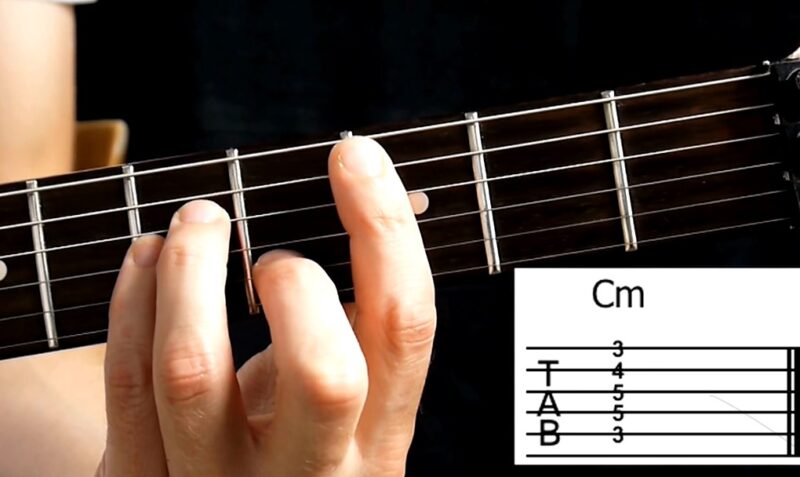
Barre chords are movable shapes that can be played up and down the guitar neck. One of the barre chord shapes for Cm is based on the “A” chord form. To play this chord, barre your index finger across all the strings at the 3rd fret and form an A-shaped chord on the 5th fret with your other fingers. This voicing allows for easy transposition to other keys.
e|—3—|
B|—4—|
G|—5—|
D|—5—|
A|—3—|
E|—x—|
Cm Barre – E Shape
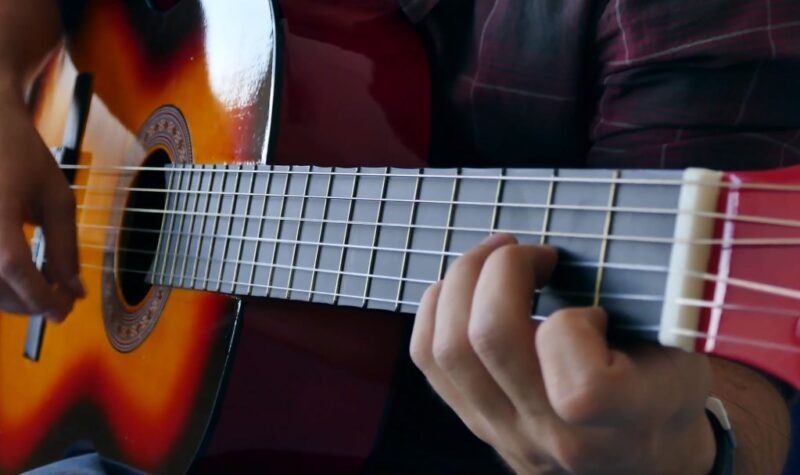
Another movable Cm barre chord is based on the “E” chord form. To play this shape, barre your index finger across all the strings at the 8th fret and form an E-shaped chord on the 10th fret using your other fingers. This voicing offers a higher-pitched and more intense sound compared to the A-shaped barre chord.
e|—8—|
B|—8—|
G|—8—|
D|—10–|
A|—10–|
E|—8—|
Cm Barre – G Shape
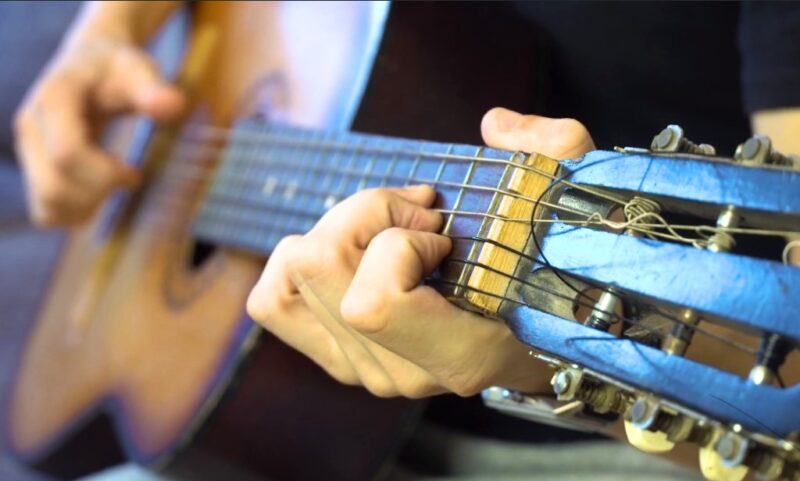
The “G” shaped barre chord is yet another variation for playing C minor on the guitar. To play this shape, barre your index finger across all the strings at the 3rd fret and form a G-shaped chord on the 5th fret with your other fingers. This voicing is useful when transitioning between different chords in the key of C minor.
e|—3—|
B|—3—|
G|—3—|
D|—5—|
A|—5—|
E|—3—|
Cm Power
Power chords are widely used in rock and metal genres, and they offer a stripped-down version of the C minor chord. To play a Cm power chord, place your index finger on the 3rd fret of the A string and your ring finger on the 5th fret of the D string. Mute the rest of the strings with your palm and strum only the A and D strings for a powerful and aggressive sound.
e|—x—|
B|—4—|
G|—5—|
D|—5—|
A|—x—|
E|—x—|
Cmadd9
The Cmadd9 chord adds a touch of complexity to the standard Cm chord. Place your ring finger on the 3rd fret of the high E string, and strum from the A string to the high E string. This voicing creates a more open and atmospheric sound.
e|—3—|
B|—3—|
G|—3—|
D|—3—|
A|—3—|
E|—x—|
Cm6
The Cm6 chord introduces a major sixth interval to the C minor triad. To play this chord, place your index finger on the 1st fret of the B string, your middle finger on the 2nd fret of the D string, and your pinky finger on the 3rd fret of the G string. Strum from the A string to the high E string. The Cm6 chord offers a softer and more jazzy quality.
e|—3—|
B|—3—|
G|—3—|
D|—3—|
A|—3—|
E|—x—|
Cm7
The Cm7 chord incorporates a minor seventh interval into the C minor triad. Place your index finger on the 1st fret of the B string, your middle finger on the 2nd fret of the D string, and your ring finger on the 3rd fret of the G string. Strum from the A string to the high E string. This voicing adds a touch of sophistication to your chord progressions.
e|—3—|
B|—4—|
G|—3—|
D|—3—|
A|—3—|
E|—x—|
Cm9
The Cm9 chord is a lush and jazzy extension of the C minor chord. To play this chord, place your index finger on the 1st fret of the B string, your middle finger on the 2nd fret of the D string, your pinky finger on the 3rd fret of the G string, and your ring finger on the 3rd fret of the high E string. Strum from the A string to the high E string for a rich and harmonically complex sound.
e|—3—|
B|—3—|
G|—3—|
D|—3—|
A|—5—|
E|—x—|
Cm11
The Cm11 chord further extends the C minor chord with an 11th interval. To play this chord, place your index finger on the 1st fret of the B string, your middle finger on the 2nd fret of the D string, your pinky finger on the 3rd fret of the G string, your ring finger on the 3rd fret of the high E string, and your pinky finger on the 3rd fret of the B string. Strum from the A string to the high E string. The Cm11 chord has a rich and evocative quality.
e|—3—|
B|—3—|
G|—3—|
D|—3—|
A|—5—|
E|—x—|
Cm13
The Cm13 chord is a complex and colorful voicing that adds a major 13th interval to the C minor chord. To play this chord, place your index finger on the 1st fret of the B string, your middle finger on the 2nd fret of the D string, your pinky finger on the 3rd fret of the G string, your ring finger on the 3rd fret of the high E string, and your pinky finger on the 3rd fret of the B string. Also, play the open low E string. Strum from the low E string to the high E string for a sophisticated and harmonically rich sound.
e|—8—|
B|—8—|
G|—8—|
D|—10–|
A|—10–|
E|—x—|
Cm/F
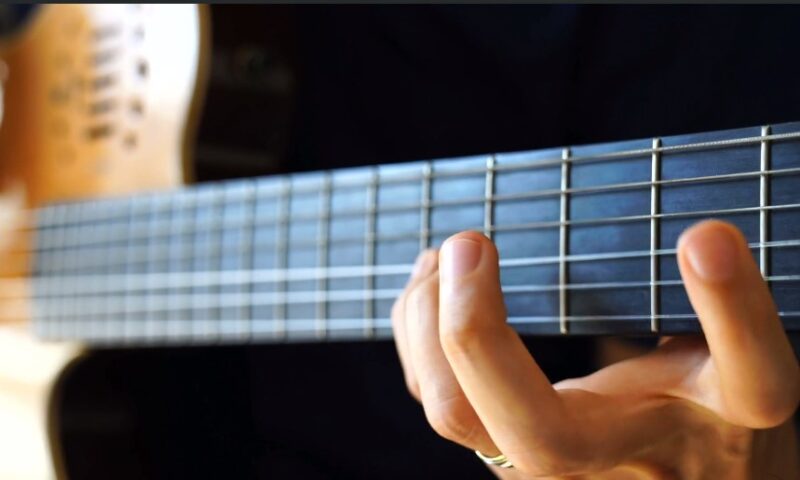
The Cm/F chord is a variation that places the F note in the bass, creating a unique and mysterious tonality. To play this chord, place your index finger on the 1st fret of the B string, your middle finger on the 2nd fret of the D string, and your ring finger on the 3rd fret of the A string. Play the low E string open to add the F bass note. Strum from the low E string to the high E string for a haunting and unresolved sound.
e|—1—|
B|—1—|
G|—1—|
D|—3—|
A|—x—|
E|—1—|
Cm/A

e|—3—|
B|—4—|
G|—5—|
D|—5—|
A|—0—|
E|—x—|
The Cm/A chord features an A note in the bass, giving it an interesting twist. To play this chord, place your index finger on the 1st fret of the B string, your middle finger on the 2nd fret of the D string, and your ring finger on the 3rd fret of the G string. Play the open A string to add the A bass note. Strum from the A string to the high E string for a slightly brighter and uplifting quality.
Cm/C
e|—3—|
B|—4—|
G|—5—|
D|—5—|
A|—3—|
E|—3—|
The Cm/C chord places the C note in the bass, adding a deep and resonant tone. To play this chord, place your index finger on the 1st fret of the B string, your middle finger on the 2nd fret of the D string, and your ring finger on the 3rd fret of the G string. Play the open high E string to add the C bass note. Strum from the A string to the high E string for a warm and grounded sound.
Cm/G Chord
e|—3—|
B|—3—|
G|—3—|
D|—5—|
A|—5—|
E|—3—|
The Cm/G chord features a G note in the bass, creating a different harmonic texture. To play this chord, place your index finger on the 1st fret of the B string, your middle finger on the 2nd fret of the D string, and your ring finger on the 3rd fret of the A string. Play the 3rd fret of the low E string with your pinky finger to add the G bass note. Strum from the low E string to the high E string for a unique and contemplative sound.
Cm/E
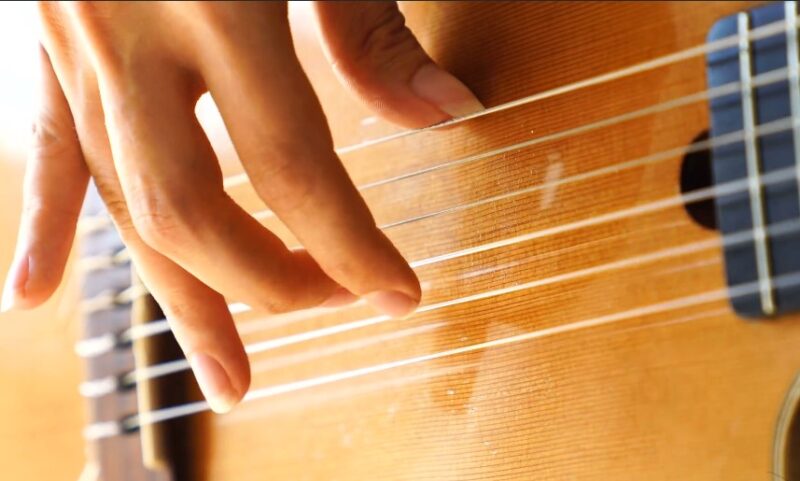
e|—0—|
B|—1—|
G|—0—|
D|—1—|
A|—3—|
E|—x—|
The Cm/E chord places an E note in the bass, offering a fresh and interesting chord voicing. To play this chord, place your index finger on the 1st fret of the B string, your middle finger on the 2nd fret of the D string, and your ring finger on the 3rd fret of the G string. Play the 2nd fret of the low E string with your ring finger to add the E bass note. Strum from the low E string to the high E string for a slightly brighter and unresolved sound.
Remember, these are simplified chord diagrams, and you may find other variations or inversions by exploring different positions on the guitar neck. Feel free to experiment with these voicings and discover the sounds that resonate with your musical style and preferences.
FAQs

Are there any other inversions of the Cm chord?
Yes, you can explore other inversions of the Cm chord by rearranging the order of the notes, such as Cm/A, Cm/C, Cm/G, and Cm/E, each with its distinctive sound.
Can I use power chords to play the Cm chord?
Yes, you can play a simplified version of the Cm chord as a power chord by placing your index finger on the 3rd fret of the A string and your ring finger on the 5th fret of the D string.
What is the purpose of playing different Cm chord variations?
Playing various Cm chord voicings adds texture and emotion to your music, allowing you to express different feelings and moods within your compositions.
How can I practice and master these chord variations?
Practice each variation slowly and accurately, ensuring that all the notes sound clear. Gradually increase your speed and practice transitioning between different Cm chord shapes to build muscle memory.
Can I use these Cm chord variations in different music genres?
Absolutely! The versatility of the Cm chord makes it suitable for various genres, including rock, blues, jazz, and pop. Experiment with these voicings to find what works best for your style.
Are these 16 ways to play the Cm chord suitable for beginners?
Some variations may be more challenging for beginners, but they offer a great opportunity to develop your finger strength and dexterity. Start with simpler shapes and gradually work your way up to the more complex voicings.
Conclusion
In conclusion, mastering the various ways to play the Cm chord on the guitar opens up a world of possibilities for expressing emotions and enhancing your musical compositions. From the standard Cm chord to the intricate Cm13 voicing, each variation brings its unique tonality and mood to your playing.
By exploring these 16 distinct Cm chord shapes, you expand your chord vocabulary and develop a deeper understanding of the guitar’s fretboard. As you practice and incorporate these voicings into your playing, you’ll find your musical expression becoming more diverse and dynamic, allowing you to evoke different feelings and moods in your music.
While some of these chord shapes may pose a challenge, don’t be discouraged. Mastery comes with consistent practice and patience. Start with simpler shapes and progress to more complex ones as you build confidence and finger strength. Remember that music is a journey, and each step you take towards honing your skills enriches your musical experience.
Additionally, these Cm chord variations are not limited to any specific music genre. Whether you’re into rock, jazz, blues, pop, or any other style, you can experiment with these voicings to add depth and texture to your compositions.
Lastly, the Cm chord serves as a gateway to musical creativity, encouraging you to explore new melodies, progressions, and harmonies. Embrace the process of discovering how each variation resonates with your unique playing style and musical preferences.
Happy playing!
